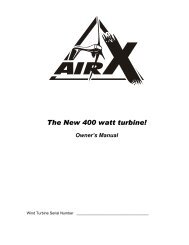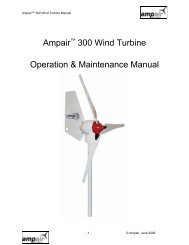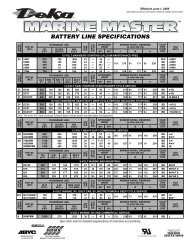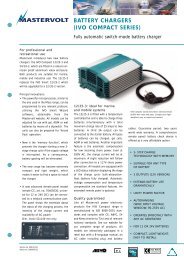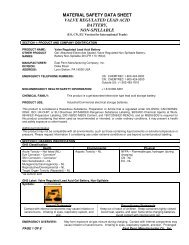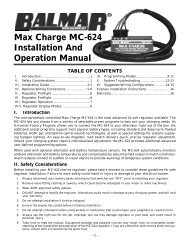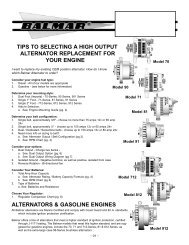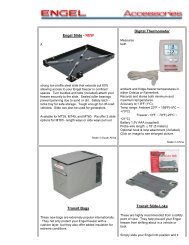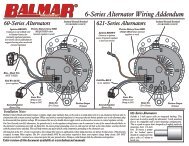IVO Compact 12/25-3 & 24/10-2 - Midsummer Energy
IVO Compact 12/25-3 & 24/10-2 - Midsummer Energy
IVO Compact 12/25-3 & 24/10-2 - Midsummer Energy
Create successful ePaper yourself
Turn your PDF publications into a flip-book with our unique Google optimized e-Paper software.
Product description<br />
The <strong>IVO</strong> <strong>Compact</strong> <strong>12</strong>/<strong>25</strong>-3(230V), <strong>24</strong>/<strong>10</strong>-2(230V)<br />
and <strong>12</strong>/20-3(<strong>12</strong>0V) are full automatic battery<br />
chargers for temperature compensated charging<br />
and maintaining the charged condition of lead<br />
batteries and supplying users connected to a<br />
battery in permanent installations. The models<br />
<strong>12</strong>/<strong>25</strong>-3(230V) and <strong>12</strong>/20-3(<strong>12</strong>0V) are provided<br />
with two main DC-outlets. The <strong>24</strong>/<strong>10</strong>-2(230V) has<br />
one main DC-outlet. The voltage drop over the<br />
DC-wires is automatically compensated.<br />
All models are provided with an additional ‘Slave’-<br />
terminal that offers the possibility to give a<br />
maintenance charge to a small second battery set<br />
(e.g. starter battery) with the same nominal<br />
voltage. The maximum charge current of the<br />
Slave Charger is 3 Amps, which is reduced from<br />
the main output of the charger<br />
Battery charger<br />
The charger is equipped with a green indicator<br />
that indicates the status of the three-step charge<br />
characteristic (see figure 1):<br />
• flashes fast = BULK charge (A), for quick<br />
charging from 0 to 80%.<br />
• flashes slowly = ABSORPTION (B), the battery<br />
is charged from 80 to <strong>10</strong>0%.<br />
• Illuminate constantly = FLOAT (C), battery is<br />
maintained in fully charged condition.<br />
ENGLISH<br />
Remote panel<br />
The optional “Charger Control” panel offers you<br />
the possibility to limit the DC-output current<br />
(Output: 5%-<strong>25</strong>%-50%-75%-<strong>10</strong>0%) and to<br />
readout the State of Charge of the battery<br />
remotely. Possible failures like under and over<br />
voltage, overheating or short circuit are reported<br />
via this remote control only by means of the<br />
failure indicator.<br />
Extended functions<br />
The RJ<strong>12</strong> connector (QRS232 communication<br />
port) can be used to connect the battery<br />
temperature sensor or the remote panel (not<br />
included). Use a splitter to connect both at the<br />
same time (not included).<br />
It is also possible to use this port to make<br />
adjustments in terms of software to your specific<br />
demands (control software and interface not<br />
included). Check the Internet site<br />
www.mastervolt.com for applications.<br />
Directions for installation<br />
• Use reliable cord end terminals to fix the wires<br />
to the DC-output and fasten all connections<br />
tightly.<br />
• Refer to specifications for the diameter of the<br />
cables to be used to connect the batteries to<br />
the charger.<br />
• Integrate a fuse in the positive wiring and<br />
place it nearby the battery. See specifications<br />
for the recommended fuse.<br />
To minimize any EMC-interference we advise to<br />
connect the negative pole of the supplying battery<br />
to the ground.<br />
Figure 1: Charge characteristic<br />
Settings<br />
There is no need to change the settings if the<br />
battery charger is used as a three-stage charger<br />
for wet batteries. Behind the front panel, right<br />
beside the RJ<strong>12</strong> connector there is a twofold DIPswitch<br />
located to activate specific functions (see<br />
figure 2).<br />
If the indicator is off while the plug of the ACcable<br />
is connected to the mains, contact your<br />
supplier.<br />
Operation<br />
The charger operates automatically. Under normal<br />
circumstances, there is no need for operation.



